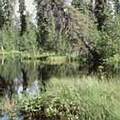 最新研究結果顯示,在溫帶地區例如美國、歐洲等地植林的結,果可能不會產生任何的益處,反而會助長氣候的暖化。此份研究報告預定於16日美國地球物理學會(American Geophysical Society)在舊金山舉行的年會中發表。
最新研究結果顯示,在溫帶地區例如美國、歐洲等地植林的結,果可能不會產生任何的益處,反而會助長氣候的暖化。此份研究報告預定於16日美國地球物理學會(American Geophysical Society)在舊金山舉行的年會中發表。
勞倫斯利福摩國家實驗室(Lawrence Livermore National Laboratory)、蒙特帕里爾大學(Université Montpellier II)及卡耐基研究所(Carnegie Institution)的科學家共同提出結論,指出森林植被有吸收陽光減少反射的作用,導致地表加熱而抵銷了吸收碳原子讓溫室氣體減少的功效。研究結果顯示,到西元2100年時,中高緯度地區的森林,會造成某些地區氣溫升高,比起沒有森林的情狀更高華氏十度。
科學家說明這是首次採用完全耦合的三維氣候與碳循環理論模式,用以探究大規模森林破壞後,氣候與碳循環效應的綜合結果。
科學家解釋,森林透過三種方式影響氣候,其中兩種可以使地球冷卻,由空氣中吸收二氧化碳溫室氣體以及使水蒸發到大氣中增加雲量兩種。「我們的研究結果顯示熱帶森林對於氣候非常有利,因為它們吸收碳原子並且增加雲量,有助於地球的冷卻。」本研究報告的共同作者大氣科學家芭拉(Govindasamy Bala)說道。
 但是森林的顏色較深將會吸收陽光,使得地球溫度上升。「高緯度北極區的新森林植被產生的深色地表,將會吸收較多的陽光,導致地表溫度上升。」芭拉指出。「事實上,由影響氣候的觀點來看,在高緯度地區植樹將會產生反效果。」
但是森林的顏色較深將會吸收陽光,使得地球溫度上升。「高緯度北極區的新森林植被產生的深色地表,將會吸收較多的陽光,導致地表溫度上升。」芭拉指出。「事實上,由影響氣候的觀點來看,在高緯度地區植樹將會產生反效果。」
該理論模式計算碳原子與氣候交互作用的結果,並且考慮氣候的物理效應,以及陸地、空氣與海洋中,由森林破壞所產生的二氧化碳排放分佈效應。其結果與熱帶森林不同,熱帶森林透過吸收二氧化碳以及蒸發大量水氣可使地球冷卻。
Planting forests in temperate regions such as the United States and Europe may not yield any benefit for the global climate, and may instead contribute to warming, according to a new study set for presentation Saturday at the American Geophysical Society annual meeting in San Francisco.
The process by which less sunlight is reflected and more is absorbed by forest canopies, heating the surface, cancels out the positive effects from the trees taking in carbon, conclude scientists from Lawrence Livermore National Laboratory, Université Montpellier II, and the Carnegie Institution.
Their research shows that, by the year 2100, forests in mid-latitudes and high latitudes will make some places up to 10 degrees Fahrenheit warmer than they would have been if the forests did not exist.
The scientists say theirs is the first study to investigate the combined climate and carbon cycle effects of large-scale deforestation in a fully interactive three dimensional climate carbon model.
Forests affect climate in three different ways, the scientists explain. They help to keep the planet cool in two of those ways. They absorb the greenhouse gas carbon dioxide from the atmosphere and that helps to keep the planet cool, and they evaporate water to the atmosphere and increase cloudiness, which also helps keep the planet cool. "Our study shows that tropical forests are very beneficial to the climate because they take up carbon and increase cloudiness, which in turn helps cool the planet," said co-author Govindasamy Bala, an atmospheric scientist.
But forests also are dark and absorb sunlight, warming the Earth.
"The darkening of the surface by new forest canopies in the high latitude boreal regions allows absorption of more sunlight that helps to warm the surface," said Bala. "In fact, planting more trees in high latitudes could be counterproductive from a climate perspective."
The models calculated the carbon-climate interactions and took into account the physical climate effect and the partitioning of the carbon dioxide release from deforestation among land, atmosphere and ocean. The story is different for the tropical forests. In tropical regions, forests help keep the Earth cool by not only absorbing carbon dioxide, but by evaporating plenty of water as well.




